It promised to be one of the great riding experiences of a motojournalist’s career. All the best riders were here, including the old guard such as Don Canet and Kent Kunitsugu. The no bullshit crowd … and for good reason.
Suzuki was introducing a 750 to the US market in Austin, Texas, the 2015 GSX-S750. For years, Suzuki owned the 750cc sportbike class with its GSX-R750, so this naked promised to be well-sorted and fun to ride. But frankly, that isn’t why most of these senior editors chose to be in Texas.
It was the guy leading the ride through the Texas Hill Country, who would also host dinner that evening at his Austin home. We were to chase Kevin Schwantz through his neighborhood, even sneaking onto the Circuit of The Americas racetrack for a couple of “sighting laps” before we were done. One of the best riders of all time, Mr. Schwantz isn’t known for a leisurely pace. Just ask Wayne Rainey or Eddie Lawson.
I thought the former 500GP champ might even be friends with the local constable. Bring your A-game or get dropped. None of these guys gets dropped on a street ride. Wouldn’t happen…would it?
The weather had other plans. The entire ride featured wet roads, and even some pelting rain and mud (some of it a color that reminded me of changing a baby diaper years ago). Mr. Schwantz rode sensibly and the group stayed upright. The track was scratched from the route.
But shitty traction tells you things about a motorcycle that pristine roads can mask. Things about balance, handling and feedback. The GSX-S750 impressed me.
You can take a look at our preview article, but here’s the skinny on the GSX-S750. Suzuki emphasizes this is a “performance street bike”, a new category for the U.S. Suzuki operation. It features a revised 749 cc inline four derived from an earlier generation GSX-R750 (the 2005 K5).
Suzuki changed the cam profiles, as well as the intake and exhaust tracts in order to increase low-end and mid-range power to create “the perfect power curve for street riding.” The whole idea was to make the GSX-S750 more powerful, and usable at street rpm levels, as well as provide increased fuel economy (Suzuki claims 48 mpg, vs 39 mpg for the GSX-R).
Suzuki incorporates a SET (Suzuki Exhaust Tuning) valve in the exhaust system to improve throttle response, while keeping noise emissions legal. An added benefit is that the Suzuki can accept an aftermarket muffler and maintain its legal status (Yoshimura had one to show off at the event).
Engineering efforts to decrease friction and improve combustion efficiency resulted in two benefits, according to Suzuki, increased power and fuel economy.
Upgrades to the fuel injection system are intended to improve throttle response and cold starting behavior. Power is delivered through a six-speed transmission.
The steel frame is a hybrid of a twin spar and tube-style design. It supports a more upright riding position somewhat typical of modern naked bikes.
The KYB cartridge forks offer spring preload adjustment, and hold a hollow three-spoke wheel with a 120/70-17 Bridgestone BT016 tire. Out back, a single shock with linkage offers seven-step preload adjustment with a box steel swingarm supporting a 180/55-17 Bridgestone BT016.
Brakes include two 310 mm rotors up front squeezed by Tokico twin piston calipers. A single 240 mm rotor and Tokico single piston caliper reside on the rear wheel.
Instrumentation includes a digital LCD speedometer with gear position indicator, fuel gauge, fuel consumption meter, clock and other information. The tach is a nice, legible analog dial. The LCD’s brightness can be adjusted.
Combined with the more practical, comfortable seating position, Suzuki gave the GSX-S750 a 4.6 gallon fuel tank for extended range.

No big lean angles today. Is it a “Kevin Schwantz replica Arai” when it is on the head of Kevin Schwantz?
Although it was difficult to push the pace in the conditions we faced at the press launch, the poor traction emphasized how well Suzuki has dialed in throttle response on the new GSX-S750. Opening a completely closed throttle resulted in no lurching, or upset of the chassis, which is critical when trying to ride smoothly in the rain. Short-shifting was the order of the day, keeping the bike in the low and mid-range, where Suzuki’s efforts to provide a real world powerband proved effective.
This is a very easy bike to ride, and the engine is plenty potent for most street riders, whether beginner or expert. You may remember 600 cc supersport riders longing for a 750 for street use due to the noticeable increase in mid-range power. The GSX-S750 takes this a step further. No need to explore the upper reaches of the tach to make quick progress.
When I did explore the upper reaches of the tach, however, I was genuinely surprised at the power available. It does not shriek on top like a GSX-R, but it does pull hard. Plenty to keep your sport bike buddies honest during an aggressive street ride.
The suspension felt firm and controlled. Exactly the way we like it on a bike intended for sport riding, without feeling harsh when chop was encountered. An extended, high speed highway sprint back to the hotel in pouring rain offered no drama (other than a brief “white out”, when my face shield and/or glasses fogged up). The bike was remarkably composed under these conditions, a testament to both the chassis and the Bridgestone tires.
The clutch and transmission worked as they should, a Suzuki trademark of sorts. No missed shifts were encountered during our hundred miles or so. This wasn’t a day to test brake power limits, but brake feel was critical in the wet, and here the Suzuki again delivered the goods.
The riding position is very slightly leaned forward, with reasonable leg room. Seat comfort remains to be judged on a longer ride when we get a test unit from Suzuki here in Southern California.
Although Suzuki could have brought this model to the U.S. a few years ago when it debuted in Europe, they waited until it could be priced competitively for the current realities of the U.S. market. The standard model of the GSX-S750 carries an U.S. MSRP of $7,999 in the only color available, the Metallic Matte Black shown. The special edition GSX-S750Z is priced at $8,149. This model adds the Blue and White paint scheme pictured below, together with brighter gold anodized forks, red rear shock spring, blue chain side plates and a different matte silver finish on the handle bar. Take a look at Suzuki’s web site for additional details and specifications. The GSX-S750 and S750Z will not be available in the California market for 2015.
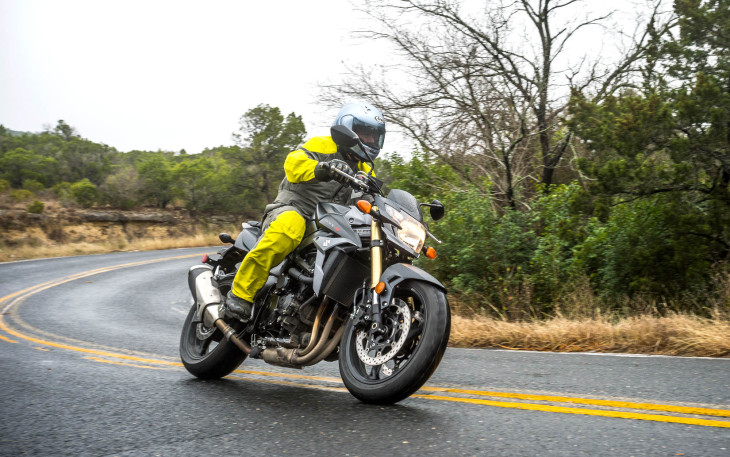
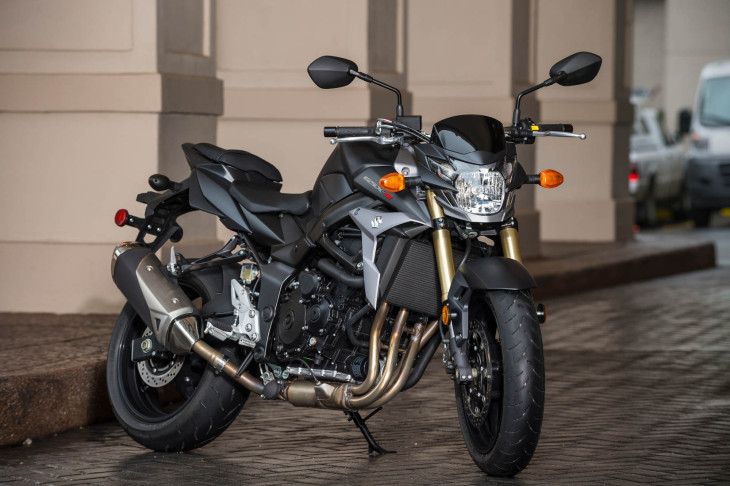
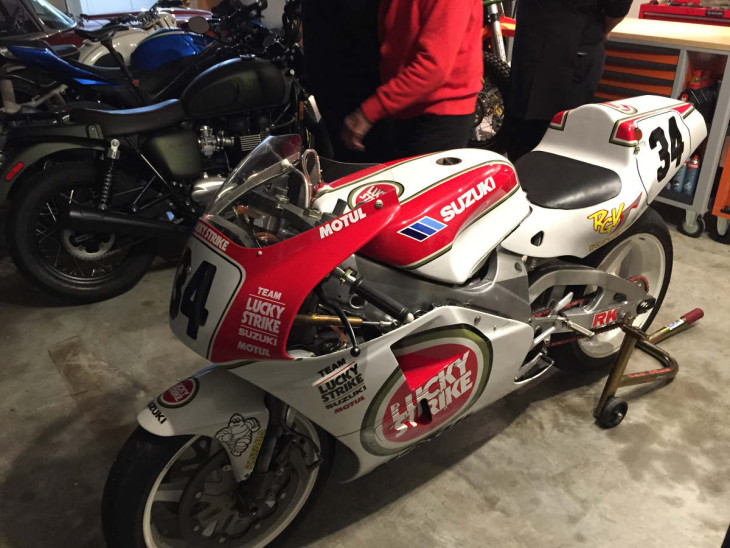
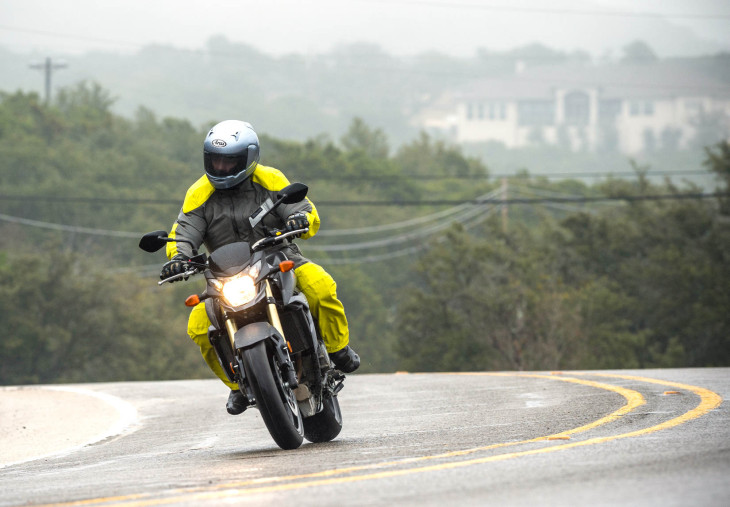
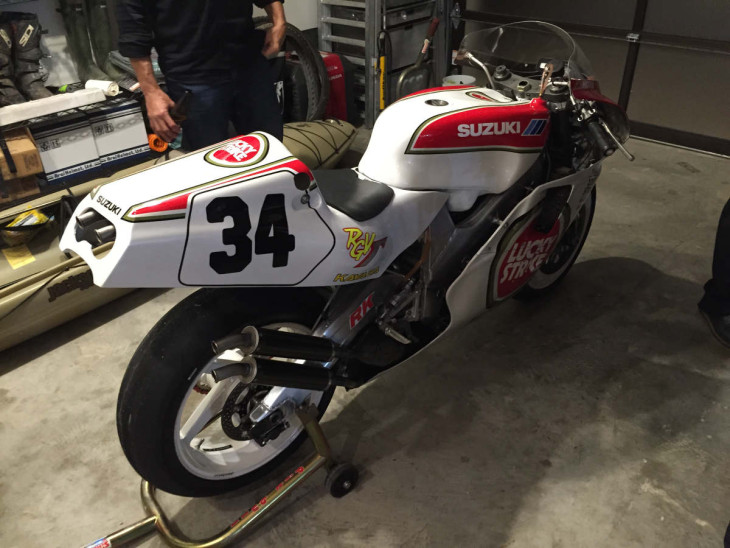
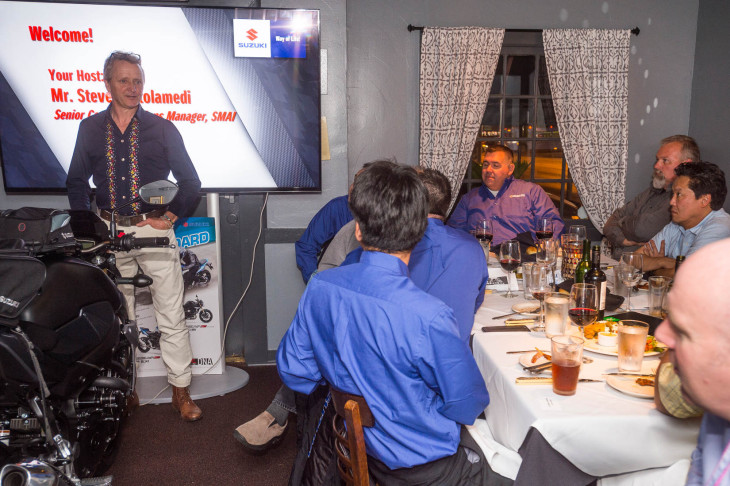
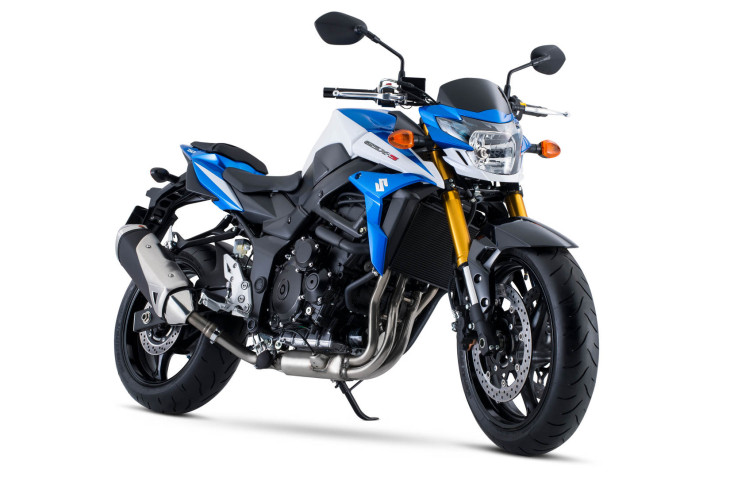
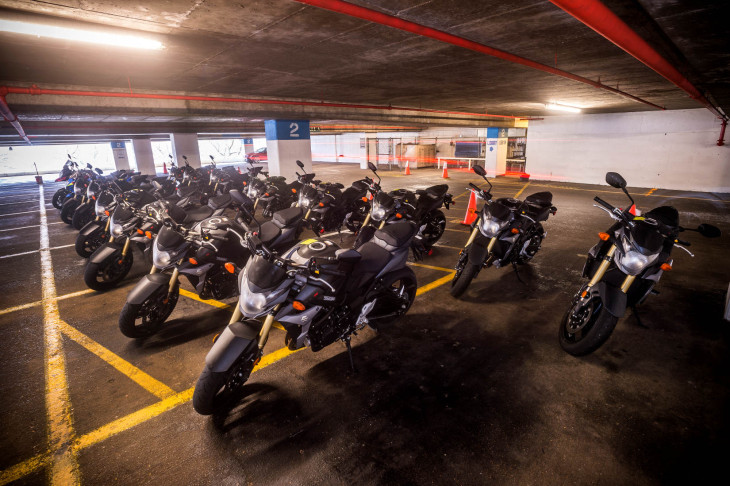
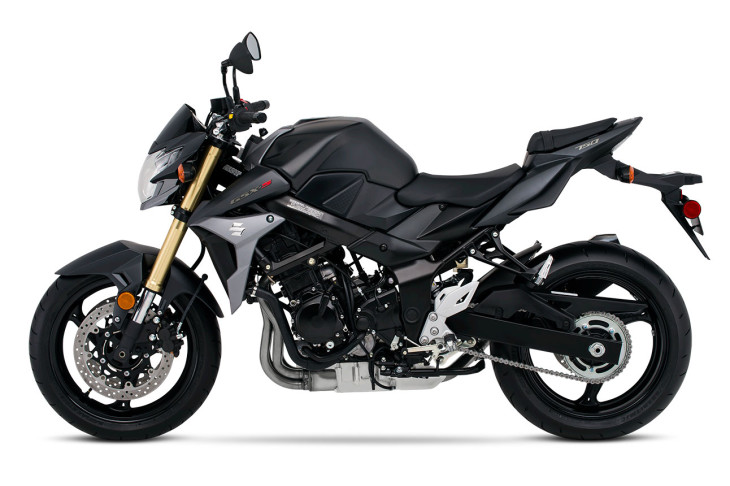







what is up with the cheap brakes and swing arm….
Cost containment. It wouldn’t be an $8k bike if all the bling were piled on. The manufacturers are nursing a rider here still recovering from the long downturn. That may not be you, it may not be me but bike sales are gaining momentum. Suzuki, and others, would be wise to be poised to drop more advanced models on us as warranted. This is not aimed directly at the seasoned rider but I’d have no problem with it at all.
I recall when box section swing arms were all the thing!
“Suzuki, and others, would be wise to be poised to drop more advanced models on us as warranted”.
Like an FZR-09 with upgraded suspension & brakes
Personally, I don’t really care about the box section swing arms… as long as it work fine and the price is right! Unless you want top of the line swing arms for track use, for the streets, it will do the job, no?
Well, I want to like this bike because I like the concept of it (I have an original GS750), but I sat on it at the cycle show and was disappointed. It looks better in pictures than in actuality. From the seat the edge line on the tank looks unflattering, and nothing else is appealing either. If you want a bike like this, I’d check out the Yamaha FZ8. Leftovers are going for $2K less than the GSX-750. Typical for Yamaha, the FZ8 looks really good, with nice proportions.
While I agree that the FZ8 is a good looking motorcycle, the power delivery is uninspiring when compared to the FZ09.
It’s not just a story of displacement. The triple demands you comply!
FZ8 has about 97 rwhp FZ09 has about 110 rwhp in crazy A mode and 100 in the B mode everybody rides in. Not that much difference
If this Suzuki has 105 rwhp as stated earlier than it’s right in there with the FZ8 and FZ09
“Not that much difference”….
WRONG
if you could ride them sequentially, you might get a clue. Look at the torque curve, it tells a different story.
Proof you say???
The FZ8 NEVER got the praise the 09 gets even with cheap forks
What does the torque curve tell you that the power curve doesn’t? You need power to change speed by a given amount in a given time, end of story.
Actually I have ridden them both of them at a Yamaha demo days at my local dealer. I much preferred the FZ8. Actually I preferred my 04 Fz-1, but that’s another story.
I had one Mickey, still wish I did as it was fantastic!
Jon,
Its just not how much, its “when” its delivered. The triple gives you more sooner, the I4 makes you wait.
For street riding, sooner is much better.
“the I4 makes you wait.”
Only if you don’t know how to shift.
The FZ-09 has a solid hp advantage everywhere on the tach plus a 60+ lb weight advantage, and you no doubt feel it. However, I’ve ridden both, and I like the FZ8’s power delivery just fine – you won’t confuse it with the FZ-09 in a straight line, but it is far from uninspiring. It is a very exciting bike above 6K rpms, in fact.
Those aren’t leftovers. It appears they are not selling.
I think the Honda 599 didn’t sell so well is it was made in a Honda factory in Italy ( for the euro market) and therefore cost a bit too much here. It’s high price stymied its sales in North America.
“The steel frame is a hybrid of a twin spar and tube-style design. It supports a more upright riding position somewhat typical of modern naked bikes.”
If it does not have an upright riding position like a 1981 Suzuki GS750EX then it is another sport-bike.
Once again a new bike lacking *1* feature to prevent me from buying it. It this instance its ABS. According to to Canadian website they offer it as an option but not the USA.
Although Suzuki could have brought this model to the U.S. a few years ago when it debuted in Europe, they waited until it could be priced competitively for the current realities of the U.S. market”
By saying this are you referring to the realty that the Yamaha FZ-09 is not only selling well, but is priced incredibly low? Not to mention the FZ-07. This is the year that everyone is chasing Yamaha. They deserve it, they are on a roll.
This is a great time to buy accessories from Japanese suppliers. The dollar is strong the yen is weak.
Looks like a job well done, Suzuki!
Dirck, tell us more about the bikes in Kevin’s garage!
I saw an old BMW R60, a modern Triumph and Suzuki of some sort, and a street legal Suzuki 2 stroke. I admit I was staring at the 500GP bike most of the time, as well as a beautiful Jaguar XKE 4.2.
I like it. A no frills naked. No fancy electronics, plain jane swingarm, basic brakes. Everything pretty much out of the parts bin.
This is a modern version of the GS750 from years gone by, only with liquid cooling.
That all equals affordable. I am very interested in the 1000 version.
I agree, nothing wrong with it–kind of like the Yamaha Radian, an unloved but quite decent motorcycle. We have gotten spoiled with the variety of scoots available. I do wish Zuki and Kawi would make some triples for us though. : – )
I’ll take mine in black thank you..
nice bike
I like the looks of the bike, and the plain-looking swingarm is acceptable to me.
The frame and swingarm are steel, though, and I thought the bike felt when I recently sat on one at the local Suzuki dealer.
Compared to the FZ-09, it feels like a lead sled just sitting on it.
It better have good power.
In my opinion, this bike should have 4-piston front calipers.
Period.
Meant to say it felt heavy.
“It better have good power.
In my opinion, this bike should have 4-piston front calipers.”
maybe yes… maybe not…
maybe upgrade to the 600RR, same power, less weight better component, but of course more expensive, I think the better components are worth it.
If the criteria comes down to better ergos, probably it’s easier to swap to a raiser and modified pegs than the other way around from the S model.
Re: “maybe upgrade to the 600RR, same power, less weight ..”
Same peak HP perhaps, but completely different “power”.
Here we go again. Apparently there are some people who think there are different types of power.
“but completely different “power””
He probably meant: it delivers the power in a different way, you have to keep the mill singing the high notes
Re: “Apparently there are some people who think there are different types of power.”
There are great differences in the way different engines deliver their power. This is why their made in so many different configurations. If you don’t appreciate that then by all means, enjoy your freedom from that concern because it drives many motorcyclists nuts.
I get that. There are some bikes with more power, some with less. Some spread their power over a wide range (2000 – 12000) and some over a narrow range (1500 – 4500). There are some that choose to put it in the middle, just like this bike.
V-Twins, Triples, I-4s
The differences in the way they deliver power are noteworthy.
“v-twins, triples, I-4s” I have one of each plus a number of singles and two-stroke singles and twins. The only differences I can tell is some of the bikes make more power than the others, some are smoother, they prefer different RPMs, and they all have vastly different sounds. Power is power. Maybe you’re confusing conventional misconceptions with something like reality.
Re: “The only differences I can tell is some of the bikes make more power than the others,”
This begs the question, why do you have so many bikes? If all these engines have only negligible differences to you then logic would dictate that you own one bike with the best fit and most powerful single-cylinder engine you can find.
“If all these engines have only negligible differences to you then logic would dictate that you own one bike with the best fit and most powerful single-cylinder engine you can find.”
Oh, please. Since when did motorcycles and logic ever go hand in hand?
“V-Twins, Triples, I-4s. The differences in the way they deliver power are noteworthy.”
Bore and Stroke. That has much more to do with how a bike delivers power than the number of cylinders it has. A four cylinder can be a torquemonster if that is what the engineer wants it to be. A twin can be a peaky whizzer if the engineer wants to maximize horsepower.
Re: “Oh, please. Since when did motorcycles and logic ever go hand in hand? ”
Every time a rider considers what best delivers what they want out of their motorcycle.
“Every time a rider considers what best delivers what they want out of their motorcycle.”
Then todd has clearly made several logical decisions to suit his wants. Logic doesn’t dictate how many motorcycles one buys. Money, desire and garage space do. I find you logic illogical!
With a bit of luck and good sales hopefully suzuki will produce an ‘R’ version of this bike like triumph did with the street triple. Quite what they would call it though who knows..
I wonder what the left side of the motorcycle looks like, or the back, or the gauge cluster…
???
+1 he must have SERIOUSLY skimmed the article
I think those pics were added afterwards.
Cheap shot Suzuki. Again we see the Japanese fudging bike design while the Europeans rage ahead.
… until they break down.
COTD
$8k doesn’t give you a lot of choices in the Euro brands.
I think it looks really nice, particularly the blue and white.
I’ll keep my 2013 Yamaha FZ8.
The swingarm. I can’t get past how much it cheapens and degrades the look of the bike, functionality notwithstanding. The Yamaha R3 does a decent job masking the box swingarm with a little plastic. I wish Suzuki would have tried a little harder on this part. Like it a lot otherwise.
A GSXR aluminum swingarm is about $30 on ebay…
Price is right but other than that nothing to get excited about.
I enjoy motorcycles.
Welcome to the club then…
this is Motorcycle Daily (read it with the “This is sparta” voice)
Who is going into the pit?
is it the guy that leases a prius so they get the newer greener model every 2 years, and only needs one car as it doesn’t break down or they get a loaner when it does due to being a new car?
This looks like a better choice than the FZ-O9 with it’s current problems but not the FJ-09 that reportedly fixed everything. I would go for the FJ-09 for the all day comfort.
Nope.
You’re not up to riding a 750 yet?
ABS?
Good point- strange that they don’t offer it, even as an option as the do on the 1000 cc bikes.
Once again Suzuki pens what I call an “nfjj” bike–not for jaded journalists.
I like the idea of a low cost bare bones naked (a real man’s bike…motor…wheels…throttle). If you want all that electronic crap buy one of those gay euro-nakeds. However I am very disappointed that Suzuki did not fit it with radial brakes.
be realistic…
the circumstances under which the power of the Radial are used are outside of the comfort zone of the chassis, geometry and suspensions (believe me there is nothing as ugly as bottoming “da front” under heavy breaking on a CRATER on the street).
I wanted to upgrade the two pots calipers of my bike to the sv1000 4 pots with braided lines… but suddenly you also have to update the suspension… and buy the best tire you can (which of course you always should)
I dearly loved my ’06 GSX-R750 for track days and twisty back roads but it was absolute torture for rush hour commuting. This new bike is on my short list.
Lets introduce a new model, but not make it available in the state with probably the biggest market of all. I know Ca. has tougher emission requirements, but I don’t see any of the other Mfgrs. with this issue.
NO mention how it compares to the Honda CB1000R, which is unchanged for 8 years now?
That bike had one glaring problem which IIRC was extreme motor vibration, at least for long term comfort. Dirck so far did not mention anything about the GS’ motor vibration or lack thereof.
I still have my CB1000R, and many criticize it because of its seemingly jerky throttle, and vibration. I realized it was geared very low stock, so I geared mine up. This changed it a lot. Not only did the throttle improve (I also went to a quarter turn throttle), by not having it be so sensitive to position, but gearing it up seemed to “load” the engine, quite effectively smoothing the engine. It still honks, wheelies, and less shifting. “Glaring problem”, I doubt it. Its smooth as any similar Honda, cept maybe a GW.
“Butter smooth is the inline-Four powering the GSX-S”,
says another journalist reviewing the bike. No high-frequency vibes anywhere in the rev range so he says.
Actually, I was surprised how low the vibration was for an I4, but the steel frame undoubtedly contributes to this. I don’t ride steel framed road bikes all that often anymore, but their vibration characteristics I often find superior to aluminum framed bikes. I find this true in the bicycle world as well. Bottom line is vibration is well controlled on the new GSX-S750.
Absolutely perfect observations. There is a niche for high-end steel bicycles for a very good reason.
The Blue and White looks great. Dirck, you lead the life…..
The blue/gold paint is definitely worth 150 bucks. Nice bike, although it is a shame the scrimped on the brakes. I’d wish for a slightly higher windshield. Hopefully it will be an available accessory.
Buy a low mileage 919 instead : pegs slightly lower and slightly forward, seat slightly lower, bars quite a bit closer to rider, Honda reliability, less origami/bug styling, room to strap on some soft luggage and gear. Add an Ohlins shock and a fork kit, then pocket the $2500 savings. Oh, buy soap to wash out the 919 exhaust stink.
Where might one find this low mileage 919?
Can’t exactly just order up your dream used bike.
My comment comes from getting a used 2007 model for $4k a couple years ago, and from watching west coast Craigslist (S.F. to Seattle) where they’ve been common. I see now that I got a bargain. I love nakeds/standards, and it’s good to see the new Suzuki. The 919 seems a better all-rounder though.
What is the warranty on this mystical low mileage 919?
Why would you need a warranty?
todd says:”Why would you need a warranty?”
Because you just drained the oil from that used 919 you bought and you’ve found chunks of metal in it. Because the clutch that felt fine 1500 miles ago when you first got it now is starting to slip. Because the radiator has developed a pinhole leak. Because the brake lines are starting to develop cracks. Because the rear wheel bearings failed three days after you bought it. Because you noticed oil seeping from around the base gasket (and now know why the previous owner had spent so much effort cleaning the engine). Because the starter motor just clicks and doesn’t turn the engine over.
Hope that clears it up for you.
You’ve never owned a Honda, eh? That stuff simply doesn’t happen with Honda stuff unless it’s been abused and neglected, which would be obvious.
Fred, I’ve been riding, daily, for the last 24 years. Not once did I need to have warranty work done. Granted, I’ve rebuilt tired old motors or replaced broken cables (and other maintenance items) but I think warranties are for KTMs, Harleys, and Modern BMWs.
Dave and Todd, I’ve been riding and wrenching for over 40 years and have owned bikes by Honda, Suzuki, Kawasaki, Yamaha, Buell, Hodaka, Ural, Aprilia, and BMW. I’ve got five bikes right now (not including project bikes), bought new and used.
In answer to Dave, I’ve owned four Hondas — two street bikes, a dual sport, and a 2-stroke motocross bike. They were okay, but nothing spectacular when it came to reliability, longevity, and build quality.
You can’t always tell whether a bike has been abused and neglected by looking it over in some guy’s driveway. There are bikes on craigslist that look fantastic but have had one oil change in their entire life — right before they were listed. There are people who do nothing but flip bikes for profit and they are very good at taking a beat-up bike and replacing and polishing just enough it look like it was cherished and garaged its whole life.
I’m not saying you can’t score some good used bikes, but let’s not pretend that warranties have no value. You discover the value of a warranty when your bike has a serious failure 300 miles away from your home and tools.
When I sold my 1985 Honda VF-750 Sabre it had close to 100k and ran like a top. Even the finish was still good.
If you are comparing it to this Suzuki, then I guess the warranty is the $3,000 to $4,000 you saved. Probably a pretty good gamble if you are not one of those guys that just have to have a new bike.
In the head to head with the FZ-09 its going to be heavier and lacking some oomph… I do think its decent looking though
The power delivery of the triple demands some respect… emulation
Hopefully you made an effort to go to Franklin BBQ for some brisket.
Dirck, you already know this, but just in case. Hard comparisons, please, this bike vs. Yamaha FZ-09 and FJ-09. These three seem to be unique in performance per dollar. In my spec-comparison the Yamaha seemed to have the edge, but real world is often the inverse of static specs. I’m over age 60. I seem to have warmed up faster to the GS styling than the Yamaha’s.
I thought the very same way, I find the Suzuki easier to warm to probably because it seems more conventional. A comparison is in order!
This is about the perfect bike. Not super high-tech, not super expensive, not super uncomfortable, no mysterious new weird gizmos, nothing tricked out. Just a straightforward, perfect bike. Want one.
Another Suzuki not available in Ca.
Bikes like this should have center-stands.
I love how Kevin has his 500 GP bike just sitting in his garage on a Pit Bull stand. Everyone else has them in a glass case. Just a regular guy.
Clean, honest bike. I like it a lot. The Euroversions claim 105 hp at the crank.
hmmm Mericans don’t much like bikes with less than 100 rwhp even if they are perfectly acceptable motorcycles..
I don’t think power output will hurt the bike’s cause at all. The big issue I think is the I4. Our fellow ‘Mericans seem to have far less prejudice against moderate power than they do against the number of cylinders producing the power.
Kawasaki struck out twice with two I4’s (the ZR7 and the Z750). Yet their twin-powered 650s sell great. Honda’s attractive and fast 599 was a flop. Yamaha’s excellent FZ8 (a bike that I also really like and the most comparable to this Suzuki I can think of) flopped as well. I have no idea how Honda’s beautiful little fully-faired 650 is selling, but I bet the answer is “not well at all.”
I’m rooting for the Suzuki. It is priced well and will be a fast bike in its segment. Recent history doesn’t give me a warm, fuzzy feeling about the bikes chances for success, though.
It’s not prejudice about the number of cylinders — it’s about the bike’s power band.
If you want to see why the Honda 599 and Yamaha FZ6 flopped compared to 650 twins from Kawasaki and Suzuki, just look at this dyno plot:
http://www.sportrider.com/sites/sportrider.com/files/styles/medium_1x_/public/import/page_element_images/146_0606_02_z%2Bfun_factor_preview%2Btorque_dyno.jpg
From idle to over 8,000 rpm, the two 650 twins have torque that stomps the Honda and Yamaha I4s. Most riders more than a few years past their learner’s permit don’t want a bike that sounds like a dentist’s drill before it starts making good power.
wow–I don’t think I’ve ever seen a 2 cylinder vs 4 cylinder comparison like that. At this point, I think I would still lean toward the 4’s hoping they would vibrate less
Who says they flopped? Without knowing how many of each were imported we can’t take what we see on the road as the whole story. I *never* see used 599’s for sale so I take that to mean that those who have them are keeping them.
I’guessing the Honda and Yamaha being more expensive (and dealer’s subsequent inventory choices) had more to do with the kawi and Suzuki’s success than a dyno chart.
That chart tells me the yamaha will accelerate the hardest and the Honda will feel the most refined, both fours. If it wasn’t for that mid RPM dip in the range for the Yamaha it would be the clear winner. Having ridden all of those bikes except the 599, I can tell you that dip doesn’t manifest itself as much as the respective torque dips on the twins do. On the yamaha, I was typically riding above where the dip happened when pushing it whereas the flat spots are right in the meat of the desired range on the twins. At least the Suzuki was smooth enough to rev out over it where the Kawasaki just felt like it needed the most help.
If the Honda looked as good as the Yamaha I probably would put more effort in trying one of those.
wow those are some crazy crooked lines. Compare those to the lines on a C2013 CB 1100 Honda and you can see why it’s such a pleasure to ride
http://www.motorcycle.com/gallery/gallery.php/v/main/reviews/2013-honda-cb1100-review/2013-Honda-CB1100-Dyno.jpg.html?g2_GALLERYSID=TMP_SESSION_ID_DI_NOISSES_PMT
That is a valid point, Fred. However, I don’t think I buy that. Had Suzuki introduced an SV650R model that produced and extra 15 hp by stuffing it all at the top of the powerband at the expense of that fat torque curve, I suspect it would have sold like hotcakes over the standard model. Buyers of sporty bikes tend to buy peak horsepower, even if torque is what they would really want. The FZ6 was a huge seller in Europe where one might think the congested cities would find such a peaky powerband in huge disfavor.
Dave, I say they flopped. Admittedly, it is just an unscientific observation on my part, but since when does anyone have to know anything to post something here? Regardless, 599 sales were dismal – ask any Honda dealer who remembers. The FZ8 didn’t last long either. Your suggestion of price probably does have a lot more to do with it than any of us are crediting it with, though.
I too (cf a couple prior replies) question “flopped” (FZ6). I got mine specifically because it does have a nice top-end rush, and having higher actual HP is useful when accelerating from already-high speeds.
For me it is totally worth the extra shifting, and my experience is the FZ is just fine in urban environments, too. More torque means you can wheelie more easily….
Todd wrote: “That chart tells me the yamaha will accelerate the hardest and the Honda will feel the most refined, both fours”
That’s not what Sport Rider found, describing the Yamaha’s engine as having “horrible throttle response” and being a “buzzy engine” that “has no bottom end.”
People don’t ride around at 9,000 rpm, so they aren’t in the meat of the power band on those I4s. They ride around at the RPM ranges where the twins shine. That’s why, in 80-100mph top-gear roll-ons, Sport Rider found that the Kawasaki and Suzuki twins were faster than the Honda and Yamaha I4s.
Interesting, Fred. Those aren’t my observations, though I don’t tend to short shift inline fours nor do I ride around at 9000 rpm. I found the Kawasaki to be the buzziest (and slowest) and the Yamaha was noticeably faster than the tw twins. I imagine a top gear roll on would be biased towards the twins since the Yamaha has a really tall top gear where you can get it up to 145ish. The Ninja can do maybe 125 so sixth on the Ninja is better compared to 5th on the Yamaha.
Great bike.
maybe 110 horses at the rear wheel? 32 inch seat height, 470 pounds, 4.6 gallon tank good for 200 miles, under 8 grand. Should be a nice bike. Will be interesting to see how well it is received.